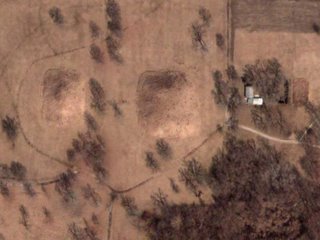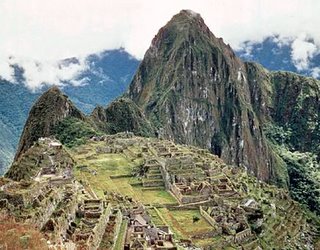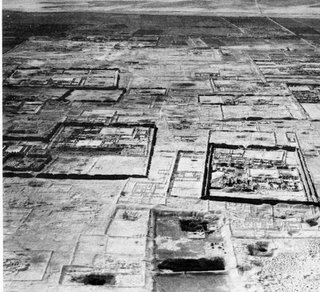kw: book reviews, nonfiction, history, western hemisphere
 I lived in Ohio in my high school years. On a family trip to the southern part of the state, we visited Serpent Mound, near Peebles. I was sixteen, and six feet tall already, and it seemed quite a bit taller. Of course, it is on the top of a ridge. It takes about five minutes to walk along its length; about a quarter mile. Its serpentine shape would make a walk along the spine of the Serpent quite a bit longer.
I lived in Ohio in my high school years. On a family trip to the southern part of the state, we visited Serpent Mound, near Peebles. I was sixteen, and six feet tall already, and it seemed quite a bit taller. Of course, it is on the top of a ridge. It takes about five minutes to walk along its length; about a quarter mile. Its serpentine shape would make a walk along the spine of the Serpent quite a bit longer.
The first image here shows Serpent Mound from above. The second is a post card from about the time I visited, around 1960.
 Continuing my review of 1491 by Charles C. Mann, I find it amazing that there is so much archeological richness in America, more than 99% overlooked or unrecognized. I recall visiting a relative in North Carolina, who took me digging for arrowheads. It isn't hard: Any road cut shows hundreds of yellowish flint chips along the older soil horizon a few inches below "modern" soil. We went into a field where we dug and sifted a couple cubic feet of dirt. There were hundreds of chips, a few dozen flake tools, and four arrow points. The site was a hunting camp, and has been dated to 8,000 years ago. It was used seasonally between that time and about 1200 AD. Even allowing for 7,000 years of use, there are huge numbers of artifacts. Agricultural areas nearby have few of the sought after "points", but much larger accumulations of various chips and flakes, made on the spot for various household uses, then discarded when dulled.
Continuing my review of 1491 by Charles C. Mann, I find it amazing that there is so much archeological richness in America, more than 99% overlooked or unrecognized. I recall visiting a relative in North Carolina, who took me digging for arrowheads. It isn't hard: Any road cut shows hundreds of yellowish flint chips along the older soil horizon a few inches below "modern" soil. We went into a field where we dug and sifted a couple cubic feet of dirt. There were hundreds of chips, a few dozen flake tools, and four arrow points. The site was a hunting camp, and has been dated to 8,000 years ago. It was used seasonally between that time and about 1200 AD. Even allowing for 7,000 years of use, there are huge numbers of artifacts. Agricultural areas nearby have few of the sought after "points", but much larger accumulations of various chips and flakes, made on the spot for various household uses, then discarded when dulled.
 Monk's Mound is shown here, with its companion mound, from above. That is a farmstead to the right!
Monk's Mound is shown here, with its companion mound, from above. That is a farmstead to the right!
At one time Serpent Mound was one of more than 10,000 mounds built by various peoples all over the Midwest and South. Most of them have been destroyed, plowed over or carted off for fill. While many were burial mounds, some such as Serpent Mound were "high places" or meeting centers, and some, such as Monk's Mound near Cahokia, Illinois, were for ceremonial use. The volume of Monk's Mound is substantially bigger than that of the Great Pyramid at Giza. It is often said of Giza that millions of slaves must have been employed for centuries. I wonder how many people it took to build Monk's Mound and its nearby, somewhat smaller (only by comparison!) companion mound?
 Looking further south, the spread of maize after its development before 1000 BC can be followed in proxy by mapping the successive high-population cultures that followed, the Olmec followed by the Maya and Aztec in Mesoamerica, and the Wari followed by the Aztecs in and near the Peruvian Andes. They built impressive cities. Machu Picchu, shown here, is the most famous in Peru...though the hardest to get to!
Looking further south, the spread of maize after its development before 1000 BC can be followed in proxy by mapping the successive high-population cultures that followed, the Olmec followed by the Maya and Aztec in Mesoamerica, and the Wari followed by the Aztecs in and near the Peruvian Andes. They built impressive cities. Machu Picchu, shown here, is the most famous in Peru...though the hardest to get to!
Severe climate shifts after about 1250 AD seem to have greatly reduced the population the land would support. The century of famines in Europe (1304-1390) is probably a related phenomenon.
 Yet great cities such as this one, Chan Chan in Peru, continued nearly until the Spanish conquest. Chan Chan itself was conquered by the Inca in about 1450, and declined rapidly. The Inca fell, first to smallpox, then to genocide, two generations later. Few stone cities are to be found in North America, though Tuzigoot (shown below) and the "Anasazi" cliff dwellings of the American southwest are awe-inspiring today. "Anasazi" is Navajo for "enemy ancestors"; they had a different name for themselves, now unknown.
Yet great cities such as this one, Chan Chan in Peru, continued nearly until the Spanish conquest. Chan Chan itself was conquered by the Inca in about 1450, and declined rapidly. The Inca fell, first to smallpox, then to genocide, two generations later. Few stone cities are to be found in North America, though Tuzigoot (shown below) and the "Anasazi" cliff dwellings of the American southwest are awe-inspiring today. "Anasazi" is Navajo for "enemy ancestors"; they had a different name for themselves, now unknown.
Finally, the presence of trade goods throughout all areas testifies to numerous vibrant, sophisticated, interlocking cultures. Kentucky Flint is found throughout the Hopewell areas from Minnesota to Pennsylvania and Louisiana, Arizona pottery was traded into Utah and Idaho to the north and Mexico to the south, and copper was traded up and down the East coast of the (pre-)U.S. by Mandoag middlemen from North Carolina.
 All of this speaks to a much greater cultural attainment than many care to think of. Lacking only iron tools, the Indians of North, Central and South America had all other accoutrements of a culture as complex and sophisticated as any European culture of the day.
All of this speaks to a much greater cultural attainment than many care to think of. Lacking only iron tools, the Indians of North, Central and South America had all other accoutrements of a culture as complex and sophisticated as any European culture of the day.
See the following posts.



No comments:
Post a Comment